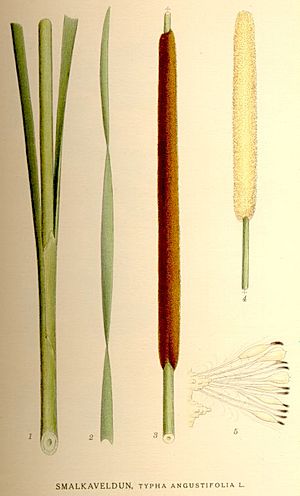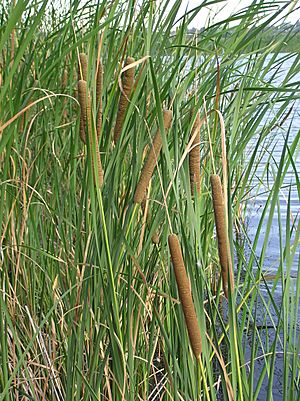Narrowleaf cattail facts for kids
Quick facts for kids Narrowleaf cattail |
|
|---|---|
 |
|
| Typha angustifolia | |
| Scientific classification | |
| Genus: |
Typha
|
| Species: |
angustifolia
|
The Narrowleaf cattail (Typha angustifolia), also called lesser bulrush or lesser reedmace, is a tall plant that lives for many years. It is a type of herbaceous plant, which means it has soft stems instead of woody ones. This cattail loves wet places, like marshes and wetlands. You can often find it in areas with slightly salty water in the northern parts of the world.
Contents
What Narrowleaf Cattails Look Like
Narrowleaf cattail plants have long, flat leaves. These leaves are quite thin, usually about ¼ to ½ inch wide. They can grow very tall, reaching 3 to 6 feet high when fully grown. Each plant shoot can have 12 to 16 leaves.
When the plant is mature, it grows a special stalk. This stalk is usually as tall as the leaves. At the top of the stalk, there is a brown, fluffy, sausage-shaped flower head. This head is where the plant's seeds are made.
Under the ground, these plants have strong, rhizomatous roots. These roots can spread out up to 27 inches. They are typically about ¾ to 1½ inches thick. These roots help the plant spread and grow in wet soil.
Where Narrowleaf Cattails Grow
Scientists believe that the Narrowleaf cattail originally came from Europe. From there, it might have been brought to North America. In North America, it is thought to have spread from coastal areas to places further inland.
The Narrowleaf cattail grows in many of the same places as another similar plant, the Broadleaf cattail (Typha latifolia). You can tell the Narrowleaf cattail apart because its leaves are thinner. Also, its flower head has a clear space between the male flowers (at the top) and the female flowers (at the bottom).
Sometimes, the Narrowleaf cattail and the Broadleaf cattail can mix together. When they do, they create a new plant called Typha x glauca, also known as the white cattail. This plant is a hybrid, which means it's a mix of two different species. However, Typha x glauca cannot make its own seeds, so it's not a new species itself. Broadleaf cattails usually grow in shallower water compared to Narrowleaf cattails.
Eating Narrowleaf Cattails
Many parts of the Narrowleaf cattail plant can be eaten. You can eat different parts during different seasons. For example, you can eat the young shoots that grow from the roots and the bases of the leaves. The inner part of the stalk is also edible.
When the plant is green, you can eat the bloom spikes. You can also collect and eat the ripe pollen. The roots are starchy and can be eaten too. These parts can be prepared in similar ways to the Broadleaf cattail. In Vietnam, the edible stem of the cattail is called bồn bồn.
Images for kids
See also
 In Spanish: Totora para niños
In Spanish: Totora para niños



